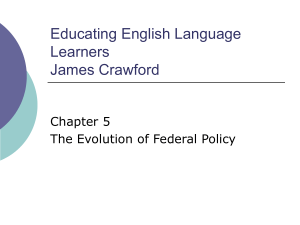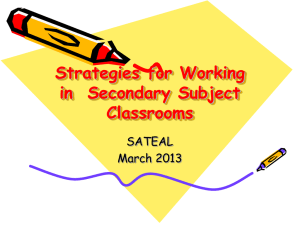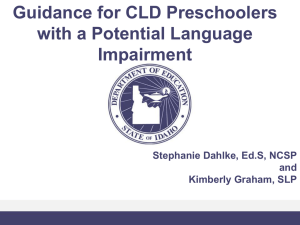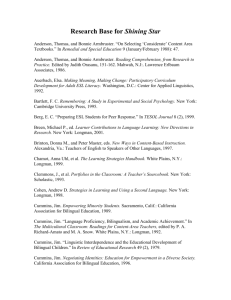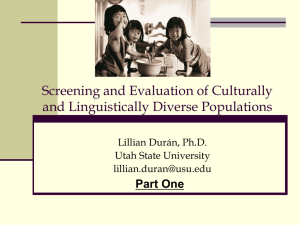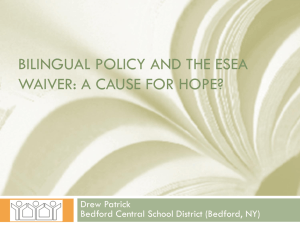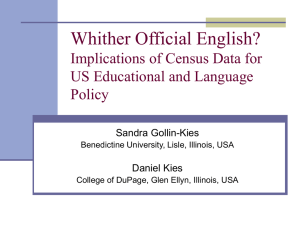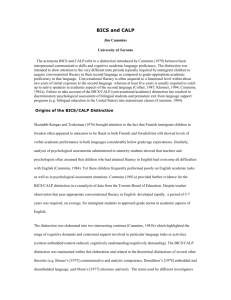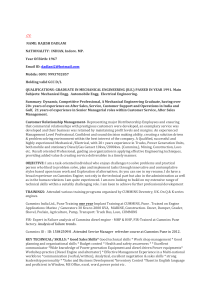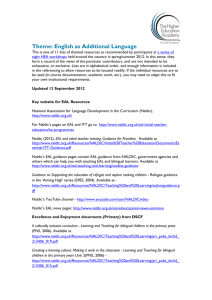learn English
advertisement
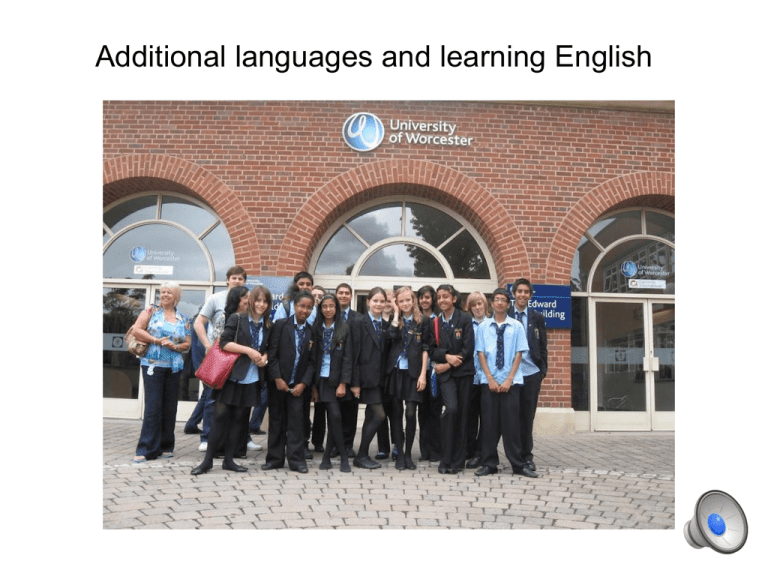
Additional languages and learning English Objectives – Apply some effective classroom teaching and learning strategies – Access additional support and strategies. Learning English in school: some policy & theoretical perspectives The policy perspective • Bilingual learners face two main tasks in the school or setting: they need to learn English and they need to learn the content of the curriculum. Learning a language involves vocabulary, grammar and pronunciation; it involves using all these appropriately for differing purposes or functions (such as questioning, analysing, hypothesising) – these need an explicit focus (National Strategies 2006). Socio cultural perspective • Being ‘fluent’ in a language means more than knowing vocabulary and structure; it means knowing which varieties of language to use, when, where, and to what purpose in local situated contexts. (Hawkins; 2010, 98) Initial learning: the receptive phase The receptive phase (silent phase) is a natural part of learning an additional language. During this phase, the child takes time to become familiar with the words and structures of the new language, and observes in order to apply rules of social engagement. To assist the child use simple, routine, visually aided routines. Support this with peer-tutoring and by enhancing a multilingual environment. Progressing the language learning Cummins and L2 Progressing the language learning • BICS – basic interpersonal communication skills – these are rapidly acquired • CALP – communicative academic language proficiency – can take much longer (think back to your iceberg…) • The fact that CALP might take some (up to 5 years in some cases!) while to appear does not mean that the child is an under-achiever or has SEN Language and culture • When students’ languages, cultures and experiences are ignored or excluded in classroom interaction, students are immediately starting from a disadvantage. Everything they have learned about life and the world up to this point is being dismissed as irrelevant to school learning (Cummins 2001) A Whole School Approach • All staff should demonstrate a willingness to learn about the cultures and background realities of the children and their families. • Every effort should be made to recruit staff who come from the same ethnic, linguistic and cultural background as the children in school. • Developing partnerships with parents, carers and communities is essential if children are to achieve their potential. • Realising these values requires the construction of an inclusive school culture. Teaching and learning strategies Effective strategies • Initial supports – using gestures to illustrate actions and activities (pointing, miming) – using visual cues to support the development of oral interactions (photographs, posters, pictures) – displaying printed phrases that are commonly used by teachers and children (flashcards) – writing and sounding out words and phrases the child can use to look for clarification (for example; ‘Can you explain that again please?’.) – simplifying texts that contain complex sentences and ideas Mainstream lessons • 1st language (L1) – recommended to help cognitive process • Lesson structure- clear signals, ILOs, visual lesson plan • Use visuals- Google images for vocabulary learning • Keywords – word cards and visuals; pointing and talking • Questions – model responses • Eye contact- check understanding Individual Support • One to one writing workshops asking questions about errors the child has made during the writing process and discussing with him/her how the errors might be corrected (linguistic detective) Bilingual books Dictionaries • The teacher may deepen engagement by.. – providing opportunities for children to create their own monolingual or bilingual dictionaries and books and enabling the child to use dictionary skills where appropriate Do Talk Record Collaborative learning NALDIC Websites and resources • • • • EAL Teaching Strategies Multilingual Matters EMAS 4 SUCCESS, Gloucestershire / Bath LA Supporting pupils with English as an Additional Language (2004) Milton Keynes LA • Guidance on the Assessment of EAL Pupils who may have Special Educational Needs, (2004) Milton Keynes LA Bibliography • Bourne, J. & Flewitt, R (2002) Teaching Pupils from Diverse Backgrounds: What do trainee teachers need to know (TTA) Accessed online 14/03/2011 http://www.naldic.org.uk/ITTSEAL2/resource/readings/BourneandFlewitt.htm • • Cummins, J. (2001) Negotiating Identities: Education for Empowerment in a Diverse Society, California: Association for Bilingual Education. Department for Education (2011a) Schools Pupils and their Characteristics http://www.education.gov.uk/rsgateway/DB/SFR/s001012/index.shtml • Department for Education (2011b) Teachers’ Standards https://www.education.gov.uk/publications/standard/publicationDetail/Page1/DFE-00066-2011 • Cummins, J., Brown, K and Sayers, D; Allyn & Bacon, (2007) Literacy, Technology and Diversity: Teaching for Success in Changing Times London: Allyn & Bacon, http://www.allynbaconmerrill.com/bookstore/product.asp?isbn=020538935X&rl=1 • • Gravelle, M (2005) Bilingual learners: bilingualism, learning and inclusion. Accessed online 14/03/2011 Hawkins, M (2010) Sociocultural Approaches to Language Teaching and Learning, in Leung, C., & Creese, A., English as an Additional Language. [online]. SAGE Publications. Available from:<http://lib.myilibrary.com?ID=262396> 14 March 2011 • • MacLean, K (2010) Children for whom English is an additional language, in Knowles, G., Supporting Inclusive Practice. [online]. Taylor & Francis. Available from:<http://lib.myilibrary.com?ID=288602> 14 March 2011 National Standards (2006) Excellence and Enjoyment: learning and teaching for bilingual children in the primary years. http://www.naldic.org.uk/Resources/NALDIC/Teaching%20and%20Learning/pri_pubs_bichd_001306_013%20leaders%20guide.pdf • • • • Introductory guide Leung C., & Creese A. (2010) English as an Additional Language. [online]. SAGE Publications. Available from:<http://lib.myilibrary.com?ID=262396> 14 March 2011 MacLean, K (2010) Children for whom English is an additional language, in Knowles, G., Supporting Inclusive Practice. [online]. Taylor & Francis. Available from:<http://lib.myilibrary.com?ID=288602> 14 March 2011 Walker, A., Dimmock, C., Stevenson, H., Bignold, B., Shah, S., Middlewood, D. (2005) Effective Leadership in Multi-Ethnic Schools National College for School Leadership http://www.nationalcollege.org.uk/index/docinfo.htm?id=17170
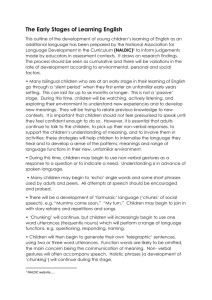
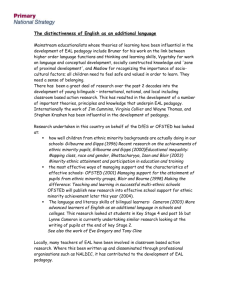
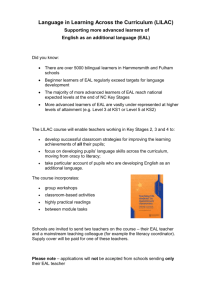

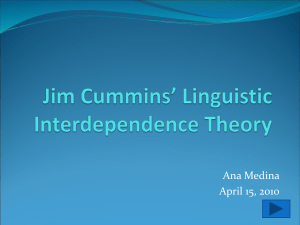

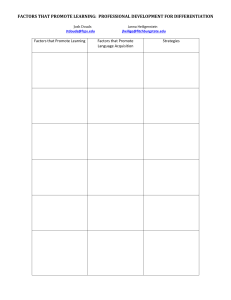
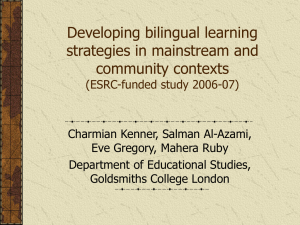

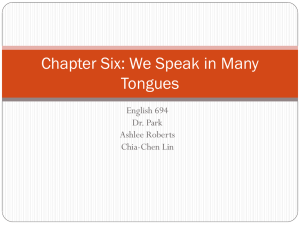
![afl_mat[1]](http://s2.studylib.net/store/data/005387843_1-8371eaaba182de7da429cb4369cd28fc-300x300.png)
